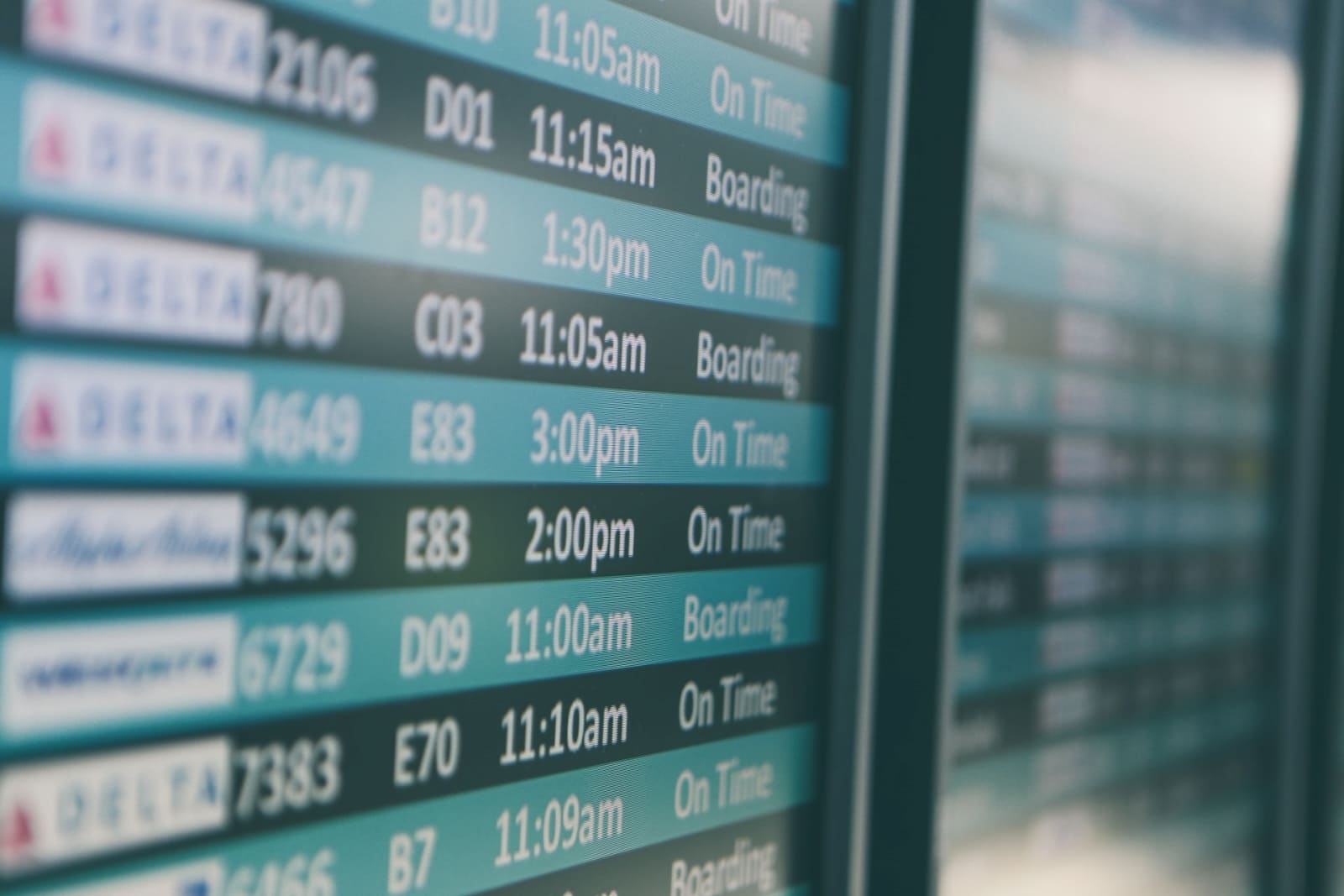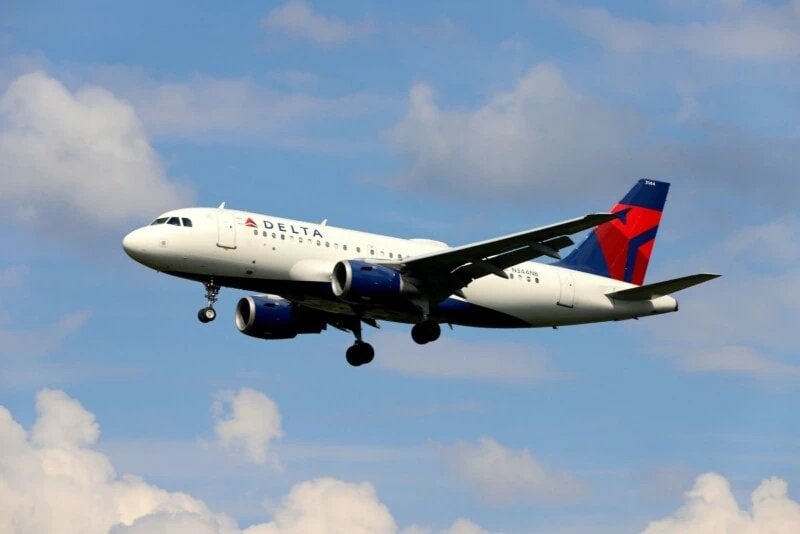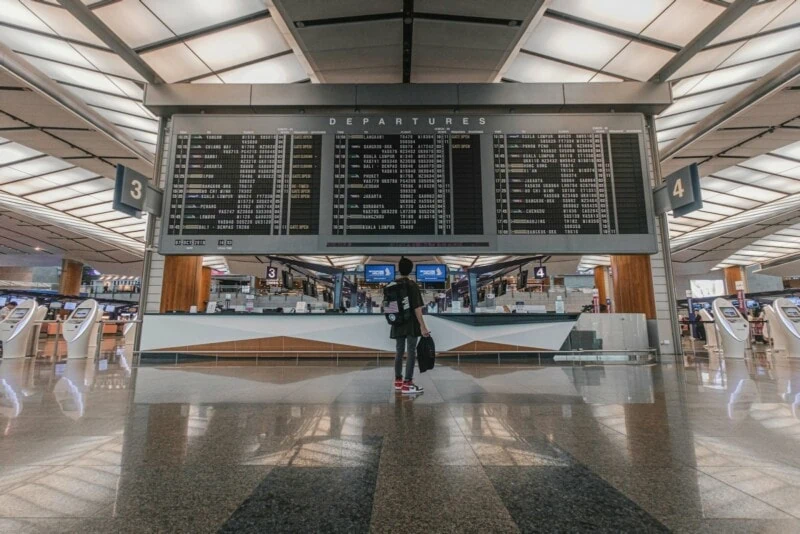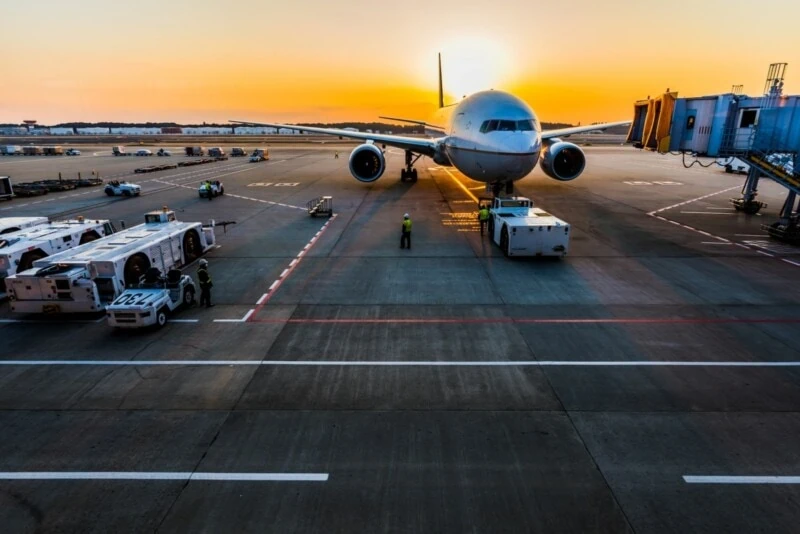
[ad_1]
Flight delays are a seemingly unending issue in the airline industry. In 2023 so far, nearly a quarter of US domestic flights arrived late or were canceled.
In most industries such a high delay rate would be considered unacceptable, but in air travel, delays are tolerated and even expected, even though they cause missed connections, lost baggage, and additional expenses.
I compiled data from 1987-2023 from the Bureau of Transportation Statistics into a massive spreadsheet to perform an in-depth data analysis of flight data. From here, I extracted a series of findings, including:
- Causes of airline delays
- Most and least delayed airlines, airports, and states
- The impact of budget airlines on flight delays
- Airline delay performance over time
Key US Airline Delay Statistics
- Most airline delays in 2022-2023 were caused by the airline, not bad weather, closed runways, or air traffic controllers.
- Over a third of delayed flights are caused by a chain reaction of delays for an aircraft earlier in its journey.
- Frontier is the most-delayed airline, with nearly 35% of flights departing late in 2023.
- Republic Airline had the fewest delays in 2023: only 12% of Republic flights were over 15 minutes late.
- The Fort Lauderdale-Hollywood International Airport (FLL) is the worst major airport for canceled or delayed flights. Over a third of flights from FLL were delayed or canceled in 2023.
- The Minneapolis-St. Paul International Airport (MSN) was the best major airport for delayed flights, with over 80% of flights leaving on time.
- Small regional airports in Idaho and Montana have the best on-time performance in the nation.
- Mississippi is the state with the lowest delay percentage, at just 14%.
- Delaware had an abysmal 55% of flights delayed in 2022, though no data is available for 2023.
Airline Delay Causes
Starting in 2003, the Bureau of Transportation Statistics began requiring major airlines to report the reason for delayed flights. Each delayed flight is assigned a code relating to one of five delay causes.
Here are the definitions of the delay causes according to the Bureau of Transportation Statistics:
- CarrierDelay: The cause of the cancellation or delay was due to circumstances within the airline’s control (e.g. maintenance or crew problems, aircraft cleaning, baggage loading, fueling, etc.).
- WeatherDelay: Significant meteorological conditions (actual or forecasted) that, in the judgment of the carrier, delays or prevents the operation of a flight, such as a tornado, blizzard, or hurricane.
- NASDelay: Delays and cancellations attributable to the national aviation system that refer to a broad set of conditions, such as non-extreme weather conditions, airport operations, heavy traffic volume, and air traffic control.
- LateAircraftDelay: A previous flight with the same aircraft arrived late, causing the present flight to depart late.
- SecurityDelay: Delays or cancellations caused by evacuation of a terminal or concourse, re-boarding of aircraft because of security breach, inoperative screening equipment, and/or long lines in excess of 29 minutes at screening areas.
Additionally, since the NAS category is quite broad, it is divided into more specific causes:
- Weather: Non-emergency weather-caused delays
- Volume: Delays caused by air traffic controllers due to the volume of flights
- Equipment: Delays caused by problems with equipment
- Closed Runway: Delays caused by a runway closed due to construction or traffic control reasons
- Other: All other delays related to the NAS and air traffic control
For this report, I broke out each delay cause by percentage. I combined all emergency and non-emergency weather delays under one category for simplicity.
Note that the table below only includes delays, not canceled or diverted flight operations.
| Airline Delays by Cause | ||||
|---|---|---|---|---|
| 2022 | 2023 | |||
| Delay Cause | % of Delays | Avg. Minutes | % of Delays | Avg. Minutes |
| Air Carrier Delay | 37.4% | 72 | 33.3% | 76 |
| Weather Delay (ALL) | 15.5% | 69 | 16.7% | 72 |
| Security Delay | 0.3% | 47 | 0.3% | 48 |
| Aircraft Arriving Late | 34.4% | 75 | 37.0% | 79 |
| NAS Volume | 0.1% | 36 | 0.1% | 37 |
| NAS Equipment Delay | 0.2% | 44 | 0.7% | 86 |
| NAS Closed Runway | 0.7% | 38 | 1.2% | 41 |
| NAS Other | 0.0% | 46 | 0.0% | 41 |
Interestingly, in 2023 the most common cause for delayed flight departure was the aircraft arriving late. Essentially, arrival delays delayed the next flight.
Admittedly, this is not a very satisfying answer, because it doesn’t immediately indicate a root cause.
What this shows, though, is the domino effect of flight delays. One late arrival delays the next flight departure, which leads to another delayed arrival, and so on. Every single delay has negative impacts down the line.
It is a fair assumption then, that every flight that was delayed by an aircraft arriving late can be attributed to one of the other causes farther back in the aircraft’s itinerary.
Airlines like to cite weather conditions or other issues outside their control as the causes of flight delays, but in reality, the most common root cause is the airline itself. Accounting for 37.4% of flight delays in 2022 and 33.3% in 2023, air carrier issues cause more delays than all other root causes combined (excluding late arrivals as a root cause).
Unfortunately, there isn’t concrete data specifying what exactly airlines did to cause these delays, only that the airline is responsible. Specific causes may include staffing shortages, aircraft maintenance, or delays in boarding passengers.
The key takeaway is that the majority of delays—those caused by air carrier operations and by the domino effect of arrival delays—are preventable and are within airlines’ control.
Flight Delay Statistics by Airline

All US airlines with more than 0.5% of the market share are legally required to report on-time performance, delay times, and delay causes for every flight.
The chart below shows the percentages of flights that are on time, delayed, or canceled by each airline in 2022 and 2023.
| Airlines Ranked by 2023 Delay Percentage | ||
|---|---|---|
| Airline | % Delayed in 2022 | % Delayed in 2023 |
| Republic Airline | 15.8% | 11.9% |
| Endeavor Air | 14.0% | 14.1% |
| SkyWest Airlines | 15.2% | 14.9% |
| PSA Airlines | 16.9% | 14.9% |
| Envoy Air | 15.2% | 16.8% |
| Alaska Airlines | 17.4% | 18.9% |
| Delta Air Lines | 16.4% | 20.0% |
| United Airlines | 19.6% | 23.6% |
| American Airlines | 21.1% | 24.1% |
| Hawaiian Airlines | 21.1% | 25.1% |
| Allegiant Air | 29.4% | 25.5% |
| Southwest Airlines | 27.9% | 26.5% |
| Spirit Airlines | 23.1% | 31.1% |
| JetBlue Airways | 31.3% | 31.2% |
| Frontier Airlines | 31.1% | 34.9% |
Across all domestic flights, 24.1% were delayed or canceled in 2023 (with delayed being defined as departing 15 minutes or more after the scheduled time). The overall average departure time was 14.43 minutes after the scheduled time.
Most On-Time Airline: Republic Airline
Republic Airline has the best flight-on-time performance of all major US carriers in 2023. With only 11.9% of flights departing late, Republic Airline performs about 10% better than the national average. That is a notable improvement from 2022, when Republic had 15.8% of flights delayed.
Republic Airline flights also depart 10 minutes earlier than average, only 4.67 minutes after the scheduled time.
Interestingly, even though it has the best on-time departure rate, Republic has the worst flight cancellation rate, with 3.32% of flights canceled in 2023.
Most Delayed Airline: Frontier Airlines
Frontier is the worst performer. A dismal 34.9% of Frontier domestic flights departed late in 2023. That means well over a third of Frontier flights either depart more than 15 minutes late or are canceled. Frontier’s average flight departure time is 29.43 minutes after the scheduled time.
Flight Delays in Large vs Small Airlines
It is interesting that the top five airlines for on-time percentage in 2023 are all quite small, with less than 3% of the market share. All but SkyWest have less than 1.5% of the market share.
The worst performers (Frontier, JetBlue, and Spirit) are also on the smaller end, though larger than the airlines in the top on-time rankings.
The “Big Four” US airlines (Delta Air Lines, American Airlines, United Airlines, and Southwest Airlines) are all around the middle of the pack. Perhaps that’s only logical though. Because large air carriers operate a massive volume of flights, due to principles of scale, their performance is bound to even out closer to the national average.
On the other hand, smaller airlines are more likely to be outliers simply because they don’t have the same volume and diversity of flights.
Of the Big Four, Delta Air Lines performed best with 78.6% of domestic flights operated by Delta departing on time. Delta also has one of the lowest rates for flight cancellations, just 1.41%.
The fifth-largest airline in the country by revenue, Alaska Airlines is the largest carrier to have an on-time rate better than 80% in 2023.
Budget Airlines and Delays
Perhaps unsurprisingly, budget airlines perform worse when it comes to delayed flights. The bottom four in 2023—Southwest Airlines, Spirit Airlines, JetBlue Airways, and Frontier Airlines—are all lower-cost carriers.
There are many explanations for why budget airlines have more delays. These include staffing issues, insufficient maintenance, and less efficient operations.
On the other hand, there is evidence that budget airlines have an overall positive impact on the punctuality of an airport.
A study by Ha V. Pham at the University of Virginia Department of Economics found that airports with the highest percentage of low-cost airline flights have shorter delay times.
I’ll say that another way. If an airport has more flights from budget airlines, the average delay time for all flights from that airport is lower.
This may seem counterintuitive, but Pham’s research suggests that the quick-turnaround approach of budget carriers frees up airport resources for other airlines to use.
Airline Delay Statistics by Airport

Differences in airline delays between different airports can also provide key insights. As it turns out, there is an even larger difference in on-time performance between airports than between airlines.
Airports with the Most Flight Delays
The table below lists the five US airports with the worst on-time arrival rates in 2023. This analysis does not take diverted flights into account, but the percentage of flights diverted is small enough to be non-significant.
| Airports with the Most Delays | ||||
|---|---|---|---|---|
| Airport | Code | % On Time | % Delayed | % Canceled |
| Stockton, CA: Stockton Metro | SCK | 51.9 | 47.8 | 0.3 |
| Aguadilla, PR: Rafael Hernandez | BQN | 56.0 | 41.1 | 2.9 |
| Ashland, WV: Tri-State/Milton J. Ferguson Field | HTS | 61.7 | 37.5 | 0.8 |
| Santa Maria, CA: Santa Maria Public | SMX | 63.9 | 36.1 | 0.0 |
| Fort Lauderdale, FL: Fort Lauderdale-Hollywood International | FLL | 64.3 | 33.1 | 2.6 |
The first point to note with the data above is that most of the airports with the worst on-time performance are smaller regional airports. As with airlines, this makes sense considering the smaller scale of these airports.
With so few flights, small regional airports are more likely to be outliers. In fact, we’ll see that the most on-time airports are also smaller regional ones. A larger airport, on the other hand, simply has more volume to average out.
The exception here is the Fort Lauderdale Hollywood International Airport, which had 33.1% of its flights delayed and 2.6% canceled so far in 2023. The fact that this major international airport ranks with these smaller outliers is striking.
When we look at the worst delay percentages only among major international airports, we can see that Fort Lauderdale had a noticeably lower on-time percentage. Other major airports with high delay rates include Orlando, Denver, Baltimore, and Las Vegas.
| Major Airports with the Most Delays | ||||
|---|---|---|---|---|
| Airport | Code | % On Time | % Delayed | % Canceled |
| Fort Lauderdale, FL: Fort Lauderdale-Hollywood International | FLL | 64.3 | 33.1 | 2.6 |
| Orlando, FL: Orlando International | MCO | 67.3 | 31.1 | 1.7 |
| Denver, CO: Denver International | DEN | 67.4 | 30.6 | 2.1 |
| Baltimore, MD: Baltimore/Washington International Thurgood Marshall | BWI | 68.2 | 30.6 | 1.2 |
| Las Vegas, NV: Harry Reid International | LAS | 68.4 | 30.2 | 1.4 |
Airports with the Fewest Flight Delays
When looking at airports with the fewest delays, small regional airports again show up as the outliers, with delay rates as low as 2.8%. I have included tables below both for the absolute highest on-time percentage as well as major airports with the highest on-time percentage.
| Airports with the Fewest Delays | ||||
|---|---|---|---|---|
| Airport | Code | % On Time | % Delayed | % Canceled |
| Pocatello, ID: Pocatello Regional | PIH | 97.2 | 2.8 | 0.0 |
| Twin Falls, ID: Joslin Field | TWF | 95.9 | 3.2 | 0.9 |
| Butte, MT: Bert Mooney | BTM | 93.9 | 4.1 | 2.0 |
| Elko, NV: Elko Regional | EKO | 93.0 | 6.6 | 0.5 |
| West Yellowstone, MT: Yellowstone | WYS | 92.8 | 6.5 | 0.7 |
| Major Airports with the Fewest Delays | ||||
|---|---|---|---|---|
| Airport | Code | % On Time | % Delayed | % Canceled |
| Minneapolis, MN: Minneapolis-St Paul International | MSP | 80.9 | 17.3 | 1.8 |
| Seattle, WA: Seattle/Tacoma International | SEA | 80.8 | 18.3 | 0.8 |
| Washington, DC: Ronald Reagan Washington National | DCA | 80.5 | 17.6 | 1.9 |
| Salt Lake City, UT: Salt Lake City International | SLC | 79.8 | 19.1 | 1.1 |
| Detroit, MI: Detroit Metro Wayne County | DTW | 79.4 | 19.0 | 1.6 |
Interestingly, 4 out of 5 of the most on-time airports in the country are small regional airports in Idaho and Montana. The most on-time major airports, on the other hand, are not concentrated in any one region.
The Pocatello Regional Airport has the best on-time performance in the country, with just 2.8% of flights delayed in 2023. It also has an impressive cancellation record, with no flight cancellations at all in 2023 so far.
Considering only larger airports, the results are far less dramatic. The Minneapolis-St. Paul International Airport had the best on-time performance of any major airport in 2023. 17.3% of flights were delayed, and 1.8% were canceled.
That’s only a 5-point difference from the national average of 22.4% of flights delayed. Minneapolis had more canceled flights on average: the national average is 1.7%.
These results indicate that smaller airports have much more ability to dramatically improve performance than international airports with larger flight volumes.
That makes sense considering that airlines cause far more delays than airport operations. Smaller airports typically have a small number of different airlines operating flights. Larger airports typically have many more airlines operating, which means poor airline performance will overpower efforts made by the airport toward punctuality to a large extent.
Airline Delay Statistics by State/Territory

Major differences in on-time performance can also be seen between different states. The table below shows the percentage of flights delayed in each US state or territory in 2022 and 2023.
| 2023 Rank | State/Territory | Delays in 2022 | Delays in 2023 |
|---|---|---|---|
| 1 | Mississippi | 16.6% | 14.0% |
| 2 | Idaho | 14.6% | 15.4% |
| 3 | Alaska | 18.5% | 15.8% |
| 4 | Oregon | 16.2% | 16.3% |
| 5 | Kansas | 18.0% | 16.8% |
| 6 | Oklahoma | 17.8% | 17.6% |
| 7 | Montana | 17.5% | 17.9% |
| 8 | North Dakota | 23.4% | 18.0% |
| 9 | Wisconsin | 17.9% | 18.0% |
| 10 | Vermont | 21.0% | 18.1% |
| 11 | Indiana | 20.2% | 18.6% |
| 12 | Arkansas | 19.3% | 18.6% |
| 13 | Minnesota | 18.6% | 18.7% |
| 14 | Washington | 18.8% | 18.8% |
| 15 | South Dakota | 20.8% | 19.0% |
| 16 | Iowa | 17.5% | 19.1% |
| 17 | Nebraska | 19.8% | 19.2% |
| 18 | Kentucky | 19.9% | 19.3% |
| 19 | South Carolina | 20.8% | 19.3% |
| 20 | Alabama | 20.6% | 19.5% |
| 21 | Utah | 16.5% | 19.7% |
| 22 | Ohio | 21.2% | 19.7% |
| 23 | Virginia | 23.0% | 20.2% |
| 24 | Pennsylvania | 19.9% | 20.2% |
| 25 | Michigan | 18.9% | 20.4% |
| 26 | Maine | 24.1% | 20.4% |
| 27 | Rhode Island | 23.2% | 20.9% |
| 28 | New Mexico | 20.2% | 21.0% |
| 29 | West Virginia | 24.0% | 21.7% |
| 30 | California | 20.3% | 22.0% |
| 31 | Hawaii | 20.6% | 22.0% |
| 32 | Wyoming | 20.2% | 22.1% |
| 33 | New Hampshire | 23.3% | 22.1% |
| 34 | Connecticut | 22.9% | 22.3% |
| 35 | Tennessee | 23.1% | 22.4% |
| 36 | Arizona | 23.3% | 22.6% |
| 37 | Louisiana | 23.1% | 23.2% |
| 38 | Missouri | 24.2% | 23.4% |
| 39 | North Carolina | 21.7% | 23.5% |
| 40 | U.S. Virgin Islands | 22.6% | 24.1% |
| 41 | New York | 26.6% | 24.2% |
| 42 | Georgia | 20.9% | 25.0% |
| 43 | Illinois | 25.8% | 25.2% |
| 44 | Massachusetts | 24.4% | 25.5% |
| 45 | Texas | 24.7% | 25.7% |
| 46 | Florida | 28.2% | 29.1% |
| 47 | New Jersey | 30.9% | 29.8% |
| 48 | Nevada | 28.2% | 30.6% |
| 49 | Puerto Rico | 27.7% | 31.4% |
| 50 | Colorado | 29.9% | 31.4% |
| 51 | Maryland | 36.6% | 32.4% |
| 52 | Delaware | 55.3% | No Data |
Mississippi, Idaho, Alaska, Oregon, and Kansas all performed consistently well in 2022 and 2023 for on-time flights. The top states for on-time flights are mostly states with less air traffic volume and lower populations overall.
Unsurprisingly, many of the states that rank worst for delays also have a major airport that is one of the most delayed in the country. For example: The Baltimore, MD; Denver, CO; and Las Vegas, NV airports are all among the most delayed major airports. Consequently, Maryland, Colorado, and Nevada rank as some of the most delayed states.
Delaware only has one relatively small regional airport (the Wilmington Airport), but delays in Delaware are far worse than in any other state, with over 55% of flights being delayed in 2022.
Sources and Methodology
All data for this report come from the Bureau of Transportation Statistics (BTS) Reporting Carrier On-Time Performance Database, which includes data from 1987 up to the present. This database includes data organized by origin and destination airport, date, and airline. The reported data includes scheduled and actual departure and arrival times, canceled and diverted flights, taxi-out and taxi-in times, causes of delay and cancellation, air time, and non-stop distance.
I accessed this data using the BTS online data tables on October 18, 2023.
Data Categories and Variables
For this report I queried the BTS data tables based on the following categories for filtering and sorting:
- Reporting_Airline: a unique carrier code indicating each airline
- OriginAirportID: an identification number assigned by US DOT to identify a unique airport—for the origin
- DestAirportID: an identification number assigned by US DOT to identify a unique airport—for the destination
- OriginState: the name and state code of the origin state or US territory
Within each filtering category, I accessed the following variables for analysis.
- PctDepOntime: a percentage of departures leaving within 15 minutes of the scheduled time
- DepDelay15: an indicator of delayed departure where over 15 minutes late is considered delayed—1 for delayed and 0 for not delayed
- DepDelayMinutes: difference in minutes between scheduled and actual departure time—early departures set to 0
- Flights: number of flights within a category
- Canceled: number of canceled flights within a category
- Cancellation Code: a number indicating the cause of delay
Analysis
After I pulled the data from the BTS tables, I performed all analysis, organization, and calculations to determine the final results.
The following values were calculated based on the available data in each category:
- Percentage of flights that were delayed
- Percentage of flights that were canceled
- Combined percentage of extreme weather delays and NAS weather delays
- Individual overall percentage of delays from individual NAS causes
For delay causes, I combined “extreme weather delays” and NAS-related weather delays under one category to give an accurate representation of all weather-related delays.
I organized and sorted the calculated results to find the most and least delayed airlines, airports, and states. Since the outlying results for airports were small regional airports, I also filtered to find the most and least delayed major international airports.
Final Airline Delay Findings
It’s clear that delayed flights are a problem that isn’t going away soon. Nearly a quarter of flights in the US depart at least 15 minutes late, and there isn’t evidence of that rate decreasing.
While it’s easy to claim that flight delays are caused primarily by weather or air traffic, the truth is that airlines themselves bear the brunt of the responsibility for delays. Some airlines do perform better than others, and budget airlines are the most often delayed.
Peer reviewed by Dr. Marcus Green, Ph.D. on November 22nd, 2023.
Airline Delay Statistics FAQs
What percentage of flights get delayed?
24.56% of flights were delayed in 2023 (up through July)
What is the biggest cause of flight delays?
The biggest root cause of delayed flights is a problem within the airline’s operation.
What is the average delay time for flights?
The average delay time for flights in 2023 was 71.4 minutes.
Which airline has the worst flight delays?
Frontier is the airline with the most delays and the longest delays on average.
Which airline has the most cancellations?
Republic Airline has the highest flight cancellation rate, with 3.31% of flights canceled in 2023.
[ad_2]





